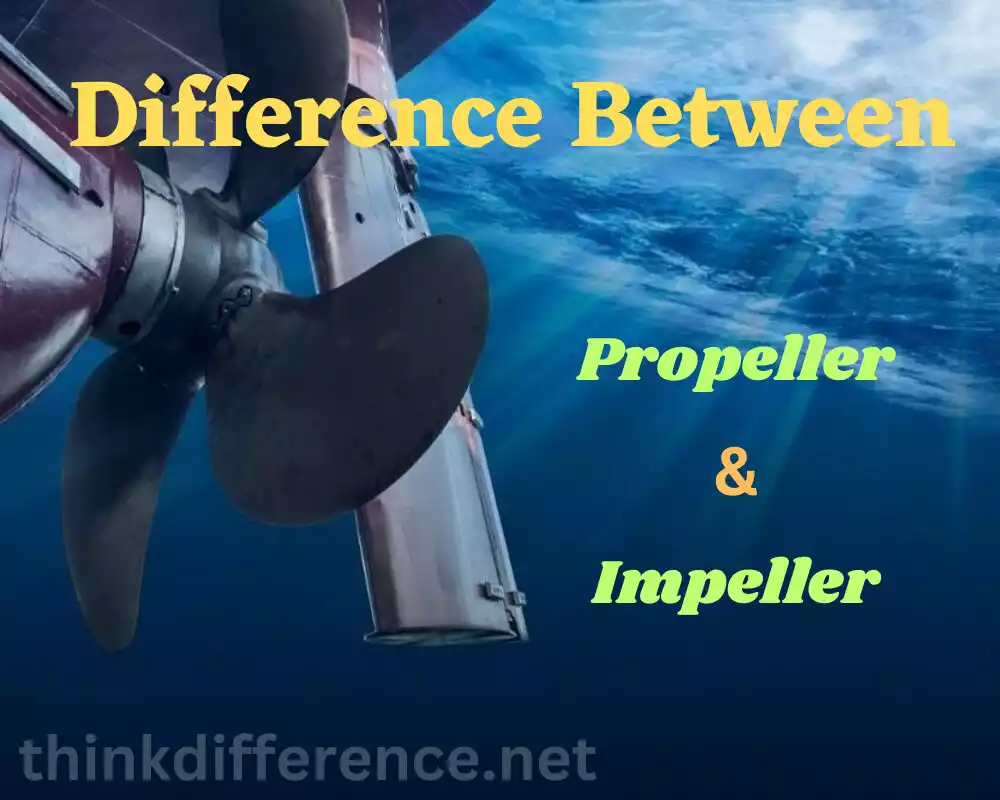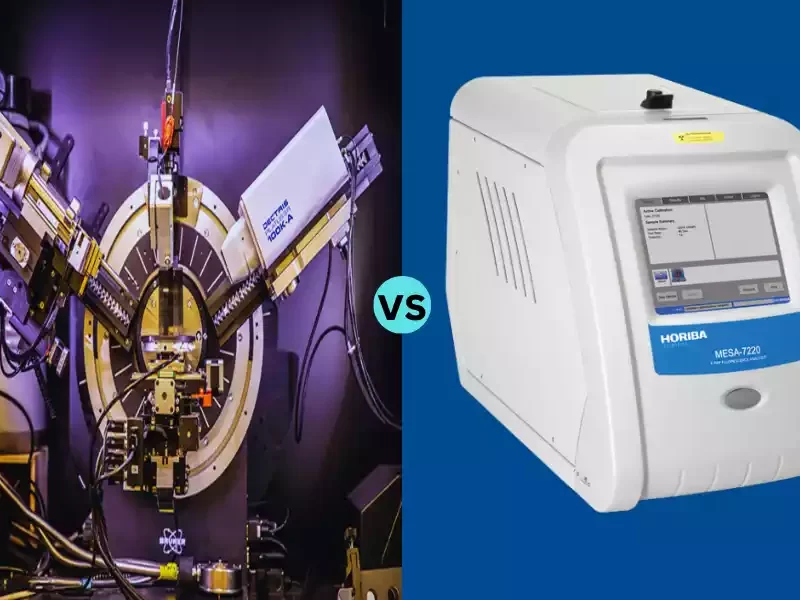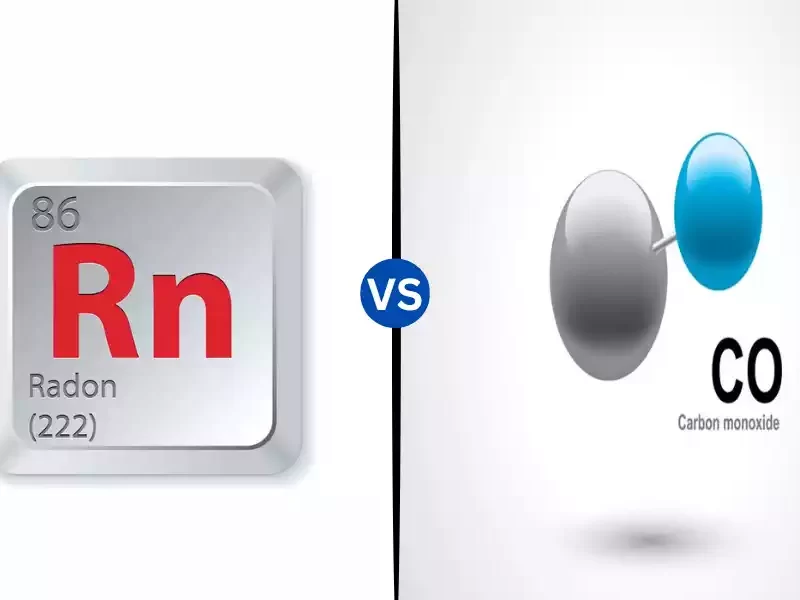Propeller and Impeller play an essential role in many industries. Both propellers and rotors, two forms of impeller are used to generate fluid flow. Their designs differ considerably when applied for different purposes. This article explores differences between impellers and propellers as well as their applications within various fields.
What is a Propeller?
A propeller is a mechanical device that consists of multiple angled blades mounted on a central hub. It is commonly used in various applications, particularly in the fields of aviation and marine transportation, to generate thrust and propel an object through a fluid or air medium.
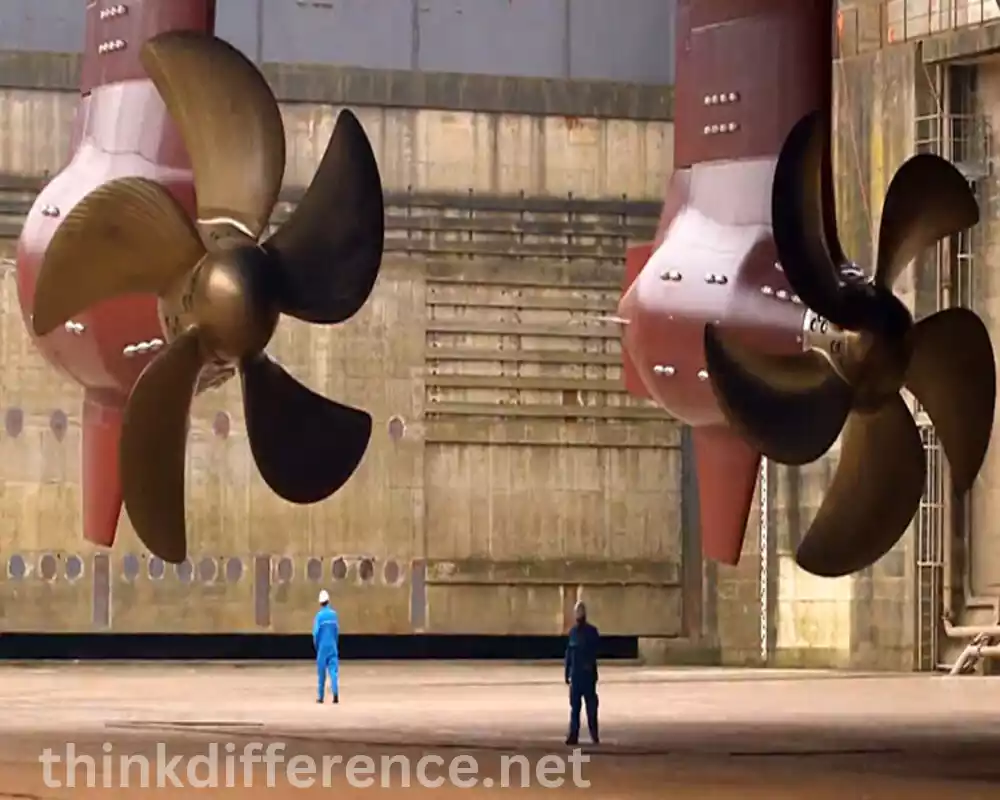
The primary purpose of a propeller is to convert rotational motion into linear motion, creating a pressure difference that propels an aircraft, boat, or other objects forward. As the propeller spins rapidly, the angled blades interact with the surrounding fluid or air, producing a force called thrust. Thrust causes the propeller to rotate in an opposite direction, altering its course.
Propellers feature several blades connected together with various angles that determine their efficiency and performance. Different materials like aluminum, composites and stainless steel may be utilized depending on its application to meet this goal.
Propellers are used to propel aircraft forward and produce thrust in aviation. Usually found near the front of an aircraft and powered by its motor or engine. The rotation of the propeller blades creates a flow of air over the wings, providing lift and enabling flight.
In marine transportation, propellers are used in boats and ships to propel them through water. They are usually located at the stern of the vessel and are driven by engines or motors. The spinning propeller blades create a flow of water, generating thrust that propels the boat forward or backward.
Propellers are also used in other applications, such as fans for ventilation or cooling systems, underwater propulsion devices, and even in certain industrial processes that involve fluid or air movement.
Propellers play a crucial role in various industries, enabling efficient and controlled movement through fluid or air mediums.
How Does a Propeller Work?
A propeller works by utilizing the principles of fluid dynamics to generate thrust and propel an object through a fluid or air medium. When a propeller rotates rapidly, the angled blades interact with the surrounding fluid or air, creating a pressure difference that results in forward motion.
Here is explanation of propeller operation:
- Rotation: Propellers are mounted onto sources of power such as motors or engines to generate rotation at high speed.
- Blade Angle: The blades of the propeller are angled or twisted along their length. This angle is known as the pitch. The pitch of the blades determines the amount of “bite” or grip they have on the fluid or air.
- Fluid Interaction: As the propeller spins, the angled blades cut through the fluid or air. This interaction causes the fluid or air to be accelerated and deflected.
- Pressure Difference: Propeller blades are constructed in such a way as to produce differential pressure between their front and back surfaces, with one having more pressure than another. In particular, their faces generally experience greater stress.
- Thrust Generation: The pressure difference between the face and the back of the propeller blades creates a force known as thrust. A propeller rotates in an opposite direction to propel an object forward.
- Newton’s Third Law of Motion: Newton’s third law states that any action has an equal and opposite reaction. As the propeller generates forward thrust, an equal and opposite reaction force is exerted on the propeller itself, which is typically absorbed by the engine or motor.
- Control and Efficiency: Propeller blade pitch, as well as other factors like number and shape of blades can be adjusted in order to increase efficiency while controlling thrust generated.
Propellers in aviation provide thrust by creating airflow over the wings to generate lift and allow flight. In marine transportation, the propeller creates a flow of water that propels the boat forward or backward.
A propeller harnesses the power of rotation, blade design, and pressure differences to convert rotational motion into linear motion, allowing for efficient propulsion through a fluid or air medium.
Applications of Propellers
Propellers find a wide range of applications across various industries due to their ability to generate thrust and propel objects through fluid or air mediums.
Some of the key applications of propellers include:
- Aviation: Propellers are extensively used in aviation for aircraft propulsion. They are commonly found in general aviation aircraft, regional turboprops, and some military aircraft. Propeller-driven aircraft provide numerous advantages, including fuel efficiency and lower operating costs; short takeoff and landing (STOL).
- Marine Transportation: Propellers are widely used in boats, ships, and watercraft for propulsion. They are typically located at the stern (rear) of the vessel and are driven by engines or motors. Propellers can be found in numerous marine applications, from recreational boats and commercial vessels to naval ships.
- Fans and Ventilation Systems: Propellers are employed in fans and ventilation systems to move air and create airflow. These fans can be used for HVAC (heating ventilation and air conditioning), industrial cooling fans and exhaust purposes. Propeller-based fans provide effective air circulation and cooling in buildings, warehouses, and industrial facilities.
- Underwater Propulsion: Underwater propulsion systems like submarines, remotely operated underwater vehicles (ROVs) and underwater thrusters utilize propellers for propulsion. They allow for controlled movement and maneuverability in underwater environments.
- Wind Turbines: Wind turbines consist of large propeller-like blades mounted on a central hub. The rotational motion of the blades, driven by the wind, is converted into electricity by a generator. Wind turbines utilize wind power to generate clean, renewable energy sources.
- Agricultural Equipment: Propellers are used in agricultural equipment, such as crop sprayers and aerial applicators, to provide thrust for aerial operations. They help distribute fertilizers, pesticides, and other chemicals effectively over agricultural fields.
- Remote-Controlled Vehicles: Propellers are commonly utilized on remote-controlled vehicles such as drones and unmanned aerial vehicles for propulsion and lift. This enables the vehicles to fly in the sky.
- Experimental and Recreational Vehicles: Propellers are utilized in experimental and recreational vehicles, including ultralight aircraft, gyroplanes, hovercraft, and personal flying devices. These vehicles rely on propellers for propulsion and flight.
These are just a few examples of the diverse range of applications where propellers play a crucial role in generating thrust and enabling efficient movement through fluid or air mediums.
What is an Impeller?
An impeller is a rotating component used in various fluid systems to move or transfer fluids or gases. It typically consists of a series of blades or vanes that are mounted on a central shaft. The impeller’s main purpose is to generate and control the flow of the fluid or gas within a system.

Unlike a propeller, which is primarily used for propulsion, an impeller is focused on creating pressure and directing the flow of the medium it is immersed in. Impellers are commonly found in centrifugal pumps, turbochargers, mixers, and other equipment where fluid movement, pressure, or energy transfer is required.
The design and configuration of impellers can vary based on the specific application and the properties of the fluid or gas being handled. Some impellers have radial blades that extend outward from the center, while others have axial blades that are oriented parallel to the shaft. There are also mixed flow impellers that combine radial and axial components.
When an impeller rotates, the blades interact with the fluid or gas, causing it to move in a specific direction. The impeller’s shape and blade design create pressure differentials and flow patterns, resulting in the desired movement or transfer of the medium.
Impellers play a crucial role in various industries and applications. For example, in centrifugal pumps, the impeller is responsible for drawing in fluid and increasing its velocity, which creates the necessary pressure for the fluid to be transported through pipes or hoses. In turbochargers, impellers are used to compress and force air into the engine, thereby improving its performance.
Impellers are also utilized in mixing equipment, where they help agitate and blend different substances or ingredients. In such applications, impellers are designed to create turbulence and promote efficient mixing within a vessel or container.
Impellers are essential components in fluid systems, responsible for generating flow, creating pressure, and transferring energy or substances. Their design and configuration depend on the specific application requirements and the characteristics of the fluid or gas being handled.
How Does an Impeller Work?
An impeller works by utilizing its rotating blades to move or transfer fluids or gases within a system. When the impeller rotates, it interacts with the surrounding fluid or gas, creating pressure differences and directing the flow in a specific direction.
Here is explanation of how an impeller works:
- Rotation: An impeller is connected to an outside source of power such as an engine or electric motor and rotates rapidly when powered up.
- Blade Design: The impeller consists of blades or vanes that are strategically positioned on a central shaft. The blade design can vary depending on the specific application and desired flow characteristics. Common impeller designs include radial, axial, and mixed flow.
- Fluid or Gas Interaction: As the impeller rotates, the blades interact with the fluid or gas medium. The shape, angle, and spacing of the blades determine how the medium flows and how pressure is created.
- Centrifugal Force: Rotation of an impeller creates centrifugal force on liquid or gas to be processed, producing centrifugal action on either. This force pushes the medium away from the center of rotation, causing it to move radially outward.
- Velocity Increase: As the fluid or gas moves away from the center of rotation, the impeller blades accelerate its velocity. The shape and orientation of the blades cause the medium to gain momentum and increase its speed.
- Pressure Difference: The acceleration of the fluid or gas by the impeller blades creates pressure differences within the system. The shape of the impeller blades and the velocity of the medium contribute to these pressure variations.
- Flow Direction: The impeller blades are designed to direct the flow of the fluid or gas in a specific direction. The shape, angle, and arrangement of the blades determine whether the flow is primarily radial, axial, or a combination of both.
- Energy Transfer: In various applications, the impeller’s main objective is to transfer energy from the rotating component to the fluid or gas. This energy transfer can be used for purposes such as pumping, compression, or mixing.
By manipulating the design and operation of the impeller, engineers can control factors such as flow rate, pressure, and energy transfer within a system. Impellers can be utilized in numerous equipment applications, from centrifugal pumps and turbochargers to mixers. Impellers serve an invaluable purpose in fluid movement applications as well as pressure generation or energy transfer processes.
Applications of Impellers
Impellers have diverse applications across various industries where fluid movement, pressure generation, or energy transfer is required. Some common applications of impellers include:
- Centrifugal Pumps: Impellers are key components of centrifugal pumps used widely across industries such as water delivery, wastewater processing, oil, gas and chemical processing. The impeller’s rotation generates centrifugal force, which increases the velocity and pressure of the fluid, allowing it to be pumped and transported through pipes.
- Turbochargers: In automotive and engine applications, turbochargers utilize impellers to compress the intake air and increase its pressure before it enters the combustion chamber. This allows for improved engine performance, efficiency, and power output.
- Mixers and Agitators: Impellers are used in mixing equipment and agitators, enabling the blending and agitation of fluids or substances. They create turbulence and promote efficient mixing within tanks or vessels, commonly found in industries such as chemical processing, pharmaceuticals, food and beverage, and water treatment.
- HVAC Systems: Impellers are utilized in heating, ventilation, and air conditioning (HVAC) systems for air movement and circulation. They are part of fans and blowers that provide airflow, cooling, and ventilation in buildings, commercial spaces, and industrial facilities.
- Water Jets and Thrusters: Impellers are employed in water jet propulsion systems, commonly used in high-speed boats, jet skis, and other watercraft. The impeller draws in water and expels it at high velocity, generating thrust for propulsion. Impellers are also utilized in underwater thrusters for remotely operated vehicles (ROVs) and other underwater propulsion applications.
- Compressors and Blowers: Impellers play a crucial role in compressors and blowers used in various industries, including HVAC, refrigeration, pneumatic conveying, and manufacturing processes. They increase the pressure and velocity of the gas or air, facilitating compression, circulation, and transportation.
- Fluidized Bed Reactors: Impellers are employed in fluidized bed reactors used in chemical processes and refineries. They help maintain fluidization of solid particles within the reactor, enhancing heat and mass transfer, and promoting efficient chemical reactions.
- Aerators and Water Treatment: Impellers are used in water treatment systems and aerators to introduce air or oxygen into water, facilitating the removal of impurities and enhancing the biological treatment processes.
These are just a few examples of the numerous applications where impellers are utilized to generate fluid movement, pressure, or energy transfer. Their versatility and effectiveness make them essential components in various industries, ranging from water and wastewater treatment to automotive, chemical processing, and beyond.
Importance of understanding the difference between Propeller and Impeller
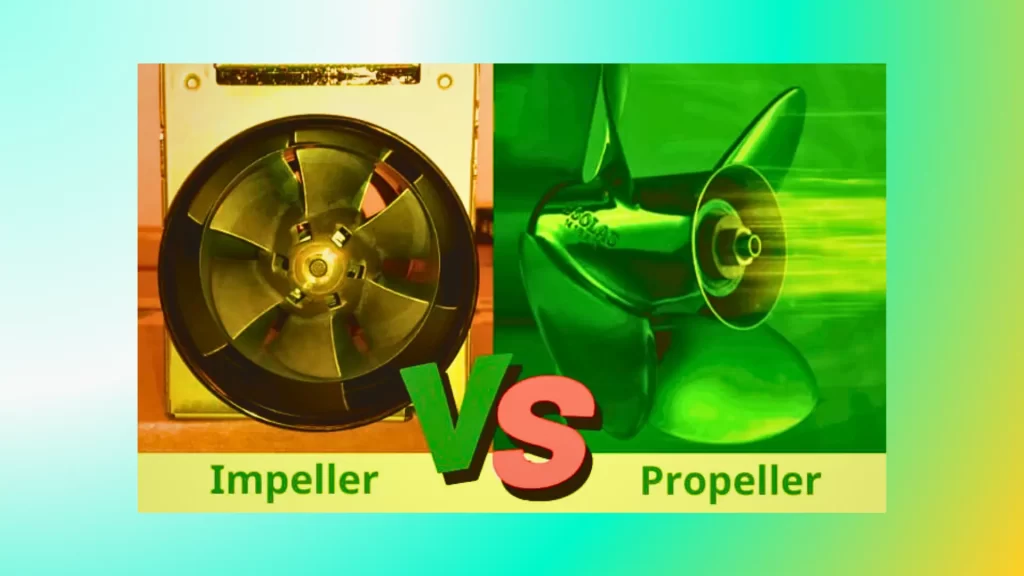
Understand the differences between an impeller and propeller is necessary for various reasons:
- Functionality: Propellers and impellers serve different purposes and operate in distinct ways. Understanding their differences allows for proper selection and application in various industries. Using the wrong type in a specific system can result in inefficient performance or even equipment failure.
- Fluid dynamics: Propellers and impellers interact with fluids and gases differently. By understanding their design and operational principles, one can grasp how they impact flow patterns, pressure differentials, and energy transfer within a system. Optimizing performance, efficiency and reliability is absolutely crucial.
- Application-specific considerations: Different industries utilize propellers and impellers based on specific requirements. Understanding the differences enables informed decision-making when selecting the appropriate device for a particular application. For example, in marine propulsion systems, propellers are commonly used, while impellers find applications in centrifugal pumps for fluid transportation.
- Efficiency and performance: Propellers and impellers have varying efficiency and performance characteristics. Knowing these differences allows for better design choices, ensuring the desired level of performance while minimizing energy consumption or loss. Efficient systems can have significant impacts on energy savings, operational costs, and environmental sustainability.
- Safety considerations: Understanding the differences between propellers and impellers is vital for ensuring safety in certain applications. For instance, working around a propeller-powered aircraft requires knowledge of its rotating blades and safety precautions. Similarly, handling impeller-driven systems, such as pumps, necessitates understanding potential hazards associated with high pressures or rotating components.
- Maintenance and troubleshooting: Proper maintenance and troubleshooting of propellers and impellers require specific knowledge about their design, operation, and potential issues. Gaining insight into these differences can aid in diagnosing issues, pinpointing possible sources of failure and developing maintenance procedures.
Understanding the distinction between propellers and impellers is essential for selecting the right device for an application, optimizing system performance, ensuring safety, and maintaining efficient operation in various industries where fluid or gas movement is critical.
Differences Between Propeller and Impeller
The differences between a propeller and an impeller can be summarized in the following aspects:
- Purpose and Function:
- Propeller: Propellers serve to provide propulsion. Their main function is providing thrust. It is designed to convert rotational motion into linear motion and move an object through a fluid or air medium.
- Impeller: An impeller serves two important roles, controlling fluid or gas flow and creating pressure within systems. It is primarily focused on moving the medium and transferring energy or pressure.
- Design and Blade Configuration:
- Propeller: Propellers typically have a larger diameter with multiple blades that are twisted along their length. The blades are usually wider and designed to push or pull the fluid or air to generate thrust.
- Impeller: Impellers often have a smaller diameter and can have different blade configurations, such as radial, axial, or mixed flow designs. The blades are narrower and are primarily designed to increase fluid or gas velocity and create pressure differentials.
- Fluid Movement:
- Propeller: Propellers are designed to move a fluid or air in a linear direction, generating thrust for propulsion. The fluid or air passes over the blades, creating pressure differences that result in forward motion.
- Impeller: Impellers are focused on creating a rotational or swirling motion within the fluid or gas. They primarily move the medium in a radial or axial direction, increasing velocity and creating pressure or energy transfer.
- Applications:
- Propeller: Propellers are commonly used in applications such as aircraft propulsion, marine propulsion, and fans for moving air.
- Impeller: Impellers find applications in centrifugal pumps, turbochargers, mixers, and other devices where fluid movement, pressure, or energy transfer is required.
- Efficiency and Performance:
- Propeller: Propellers are designed for efficient conversion of rotational energy into forward thrust. They are optimized for speed and propulsion efficiency.
- Impeller: Impellers are designed to increase the velocity and pressure of the fluid or gas within a system. Their efficiency is focused on achieving the desired flow rate and pressure differentials.
Understanding these differences is crucial for selecting the appropriate device for a specific application, optimizing performance, and ensuring efficient operation within various industries.
Similarities Between Propeller and Impeller
While Propellers and Impellers have distinct differences, they also share some Similarities. Here are a few key similarities between Propellers and Impellers:
- Fluid or Gas Movement: Both propellers and impellers are designed to move fluids or gases. While the direction and purpose of movement differ, they both play a role in transferring or manipulating the medium they are immersed in.
- Role in Various Industries: Propellers and impellers have widespread applications in various industries. They are integral components in transportation, energy, and fluid handling sectors, contributing to propulsion, pumping, mixing, and other fluid-related processes.
- Importance in Transportation: Both propellers and impellers play crucial roles in transportation systems. Propellers are commonly used in aircraft and marine vessels for propulsion, while impellers are employed in pumps and turbochargers for fluid or gas movement in engines.
- Design Considerations: Both propellers and impellers require careful design considerations. Factors such as blade shape, material selection, and performance optimization are vital for achieving efficiency, reliability, and desired fluid dynamics.
- Engineering Principles: Both propellers and impellers are designed based on principles of fluid dynamics and engineering. Factors such as blade angles, rotational speed, and fluid characteristics are taken into account to achieve optimal performance and desired outcomes.
- Industrial Applications: Propellers and impellers find applications in numerous fields, including aviation, maritime transportation, oil & natural gas production and chemical processing as well as water treatment systems. They contribute to tasks like mixing, pumping, circulation, and fluid flow management.
While propellers and impellers may have different functions and operational principles, their shared importance in fluid movement and their applications in various industries make them significant components in the field of fluid dynamics and engineering.
Common Industries Utilizing Propellers and Impellers
Propellers and impellers find extensive use in a wide range of industries that require fluid movement, pressure generation, or energy transfer.
Here are some common industries that utilize propellers and impellers:
- Marine and Maritime: The marine industry extensively utilizes propellers for propulsion in ships, boats, submarines, and other water vessels. Propellers are crucial for achieving efficient propulsion, maneuverability, and speed on the water. They are commonly found in commercial shipping, naval vessels, recreational boats, and offshore platforms.
- Aviation: Propellers play a vital role in aviation, particularly in general aviation and smaller aircraft. Propeller-driven aircraft utilize propellers as thrust generators and propulsion mechanisms. They are commonly employed in light aircraft, turboprops, regional airliners, and certain military aircraft.
- Water and Wastewater Treatment: Impellers are widely used in water and wastewater treatment processes. They are utilized in pumps and mixers for processes such as water circulation, aeration, sludge mixing, and chemical dosing. Impellers ensure efficient mixing, oxygen transfer, and chemical distribution, contributing to effective treatment and quality control.
- Chemical Processing: Chemical processing industries employ impellers in various applications, such as mixing, blending, and agitation of liquids and solutions. Impellers are crucial in reactors, tanks, and mixing vessels for processes involving chemical reactions, dissolution, suspension, or emulsification. They facilitate uniform mixing and enhance heat and mass transfer.
- Oil and Gas: Impellers and propellers play an indispensable role in the oil and gas sector, serving multiple functions. Propellers are employed in marine vessels and offshore platforms for propulsion and positioning. Impellers are utilized in pumps and compressors for fluid transportation, oil refining, gas processing, and pipeline operations. They help facilitate fluid flow, pressure boosting, and energy transfer.
- HVAC and Refrigeration: Impellers play an indispensable role in HVAC, refrigeration and heating systems. They are part of fans, blowers, and air handling units that circulate air, provide ventilation, and regulate temperature in commercial buildings, residential spaces, and industrial facilities.
- Automotive and Transportation: Propellers and impellers play a role in the automotive and transportation industry. In addition to propellers used in marine vessels, impellers are employed in automotive water pumps for coolant circulation in engines. Turbochargers, which utilize impellers, are used to improve engine performance and efficiency in automobiles and trucks.
- Power Generation: Propellers and impellers have applications in power generation industries. Hydroelectric power plants utilize propellers to convert the mechanical energy contained within flowing water into electrical energy for generators to drive. Impellers are employed in steam and gas turbines, as well as in cooling systems, for efficient fluid circulation and energy transfer.
Here are several industries which use propellers or impellers in various applications. The versatility, efficiency, and reliability of propellers and impellers make them indispensable components in fluid systems across diverse sectors.
Advancements in Propeller and Impeller Technology
Advances in propeller technology have been driven by the demand to enhance performance, efficiency and reliability.
These being some of the notable developments:
- Computational Fluid Dynamics (CFD): The use of CFD simulations has revolutionized propeller and impeller design. It allows for detailed analysis and optimization of fluid flow patterns, pressure distributions, and performance characteristics. CFD simulations enable engineers to refine the shape, size, and blade geometry of propellers and impellers, leading to more efficient and effective designs.
- Advanced Materials: Advanced alloys and composite materials have greatly increased propeller durability and performance, offering increased corrosion resistance with decreased weight, as well as mechanical properties enabling higher speeds with lower maintenance needs.
- Additive Manufacturing (3D Printing): Additive manufacturing techniques have opened up new possibilities in propeller and impeller production. 3D printing allows designers to craft intricate and complex designs which would otherwise be impossible with traditional methods. This technology allows for rapid prototyping, customization, and optimization of propellers and impellers.
- Computational Optimization Algorithms: Advanced optimization algorithms are being used to optimize the design parameters of propellers and impellers. These algorithms, combined with CFD simulations, enable engineers to find the best combination of blade shape, twist, angle, and other factors to maximize performance, efficiency, and minimize cavitation or noise.
- Active Flow Control: Active flow control techniques, such as the use of smart materials, actuators, or surface modifications, are being explored to enhance the performance of propellers and impellers. These techniques allow for real-time control of the flow patterns, reducing turbulence, improving efficiency, and mitigating issues like cavitation or noise.
- Computational Design Tools: Advanced software tools and design platforms have been developed specifically for propeller and impeller design. These tools combine databases, algorithms and modeling capabilities in order to streamline design processes by eliminating trial-and-error iterations cycles while increasing performance and decreasing iterations times.
- Blade Tip Clearance Optimization: The optimization of blade tip clearances in impellers has gained attention as it can significantly affect the performance and efficiency of pumps, compressors, and turbines. Advanced clearance control techniques and designs, such as brush seals or adjustable clearances, help minimize leakage and improve overall system efficiency.
- Noise Reduction: Are efforts being undertaken to limit noise emissions produced by propellers or impellers used in various applications like aviation and HVAC systems? Advanced aerodynamic designs, noise-damping materials, and active noise control techniques are being employed to minimize noise pollution while maintaining performance.
Propeller and Impeller developments continue to provide significant advancements in performance, efficiency and reliability across a variety of industries. These advances allow the creation and deployment of eco-friendly fluid systems which use less power. As technology improves and research continues propellers and impellers will only become better over time.
Summary
Propellers and Impellers are integral components in fluid mechanics and machinery. While propellers excel in propulsion applications, impellers shine in fluid transportation and agitation tasks. Understanding their unique characteristics and applications allows us to make informed decisions in choosing the right component for specific needs.

